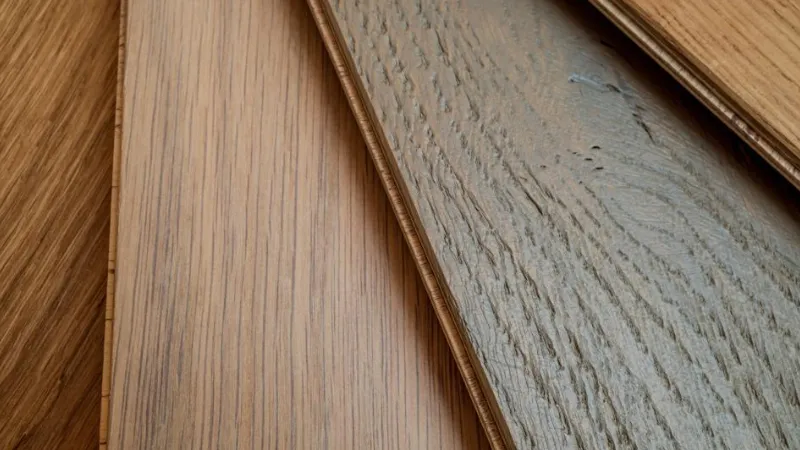For a more thorough examination of engineered vs. hardwood flooring to help you which one is better for you.
The way the planks are constructed is the primary distinction between engineered and solid wood flooring. This in turn has an impact on how, when, and where they can be used. The decision between engineered and solid flooring typically comes down to personal preference as well as the location and method of installation.
Please read on for more detailed information.
Engineered Vs Solid Hardwood
You will need to choose the type of wood floor that is best for your room and project right away. Yes, you have options on this too, which is great!
Simply put, you have your choice of two wood flooring construction types: Engineered and Solid.
Because they are a partially manufactured product, engineered wood floors get their name. That is, they are “engineered” rather than grown naturally like standard wood. Like many other excellent flooring options, engineered flooring is made of layers, which helps to give it strength. Engineered flooring is made up of a base or supporting layer, often of lesser grade wood or plywood, covered in a softwood plywood core (as “softwood” is cheaper than “hardwood”) topped with a hardwood veneer and a protective finish coat.
The veneer in engineered wood works its magic. The veneer is made of real wood, just a smaller amount than what would be found in solid wood floors. However, don’t mistakenly assume this fabrication and construction means engineered wood flooring less expensive than its hardwood counterpart. The cost of engineered wood can easily rival that of solid wood and is based on a few factors including the thickness of the veneer, width and length of the board, type of finish or wear-layer, species of wood, location of the manufacturer (United States, Canada, Vietnam, and China are common suppliers), and the type of wood used in the ply (typically oak, hickory or poplar).
Solid wood flooring is solid, as you may have guessed. Okay, all kidding aside, that’s probably the most literal name in flooring, and it’s made of wood. Solid wood planks that have been shaped and planed are used for flooring. It’s really that easy.
Typically 3/4″ or 5/8″ thick, solid wood flooring is permanently affixed to the subfloor using nail or glue. Don’t look for “floating” or “click-lock” options for traditional solid wood floors; as it is wood, humidity and temperature changes will cause the boards to flex and move so the nailing or gluing is required.
Solid hardwood flooring can be screened and refinished more frequently than the thinner veneer of engineered wood flooring. depending on the texture and depth of the finishing treatments, typically up to an average of 3-5 times, more often than you will likely need in a lifetime. Most homes will not require a deeper sanding for refinishing, and this harsh maintenance should be used sparingly on solid wood floors, and never used on engineered wood. For engineered wood flooring, the veneer needs to be at least 2 millimeters thick in order to be screened and refinished like solid wood floors and increase the flooring’s lifespan. Due to the thin veneer, it can only be refinished occasionally, if at all. However, if installed, finished, and regularly maintained, the need for refinishing is greatly reduced, meaning your wood floors can last a lifetime.
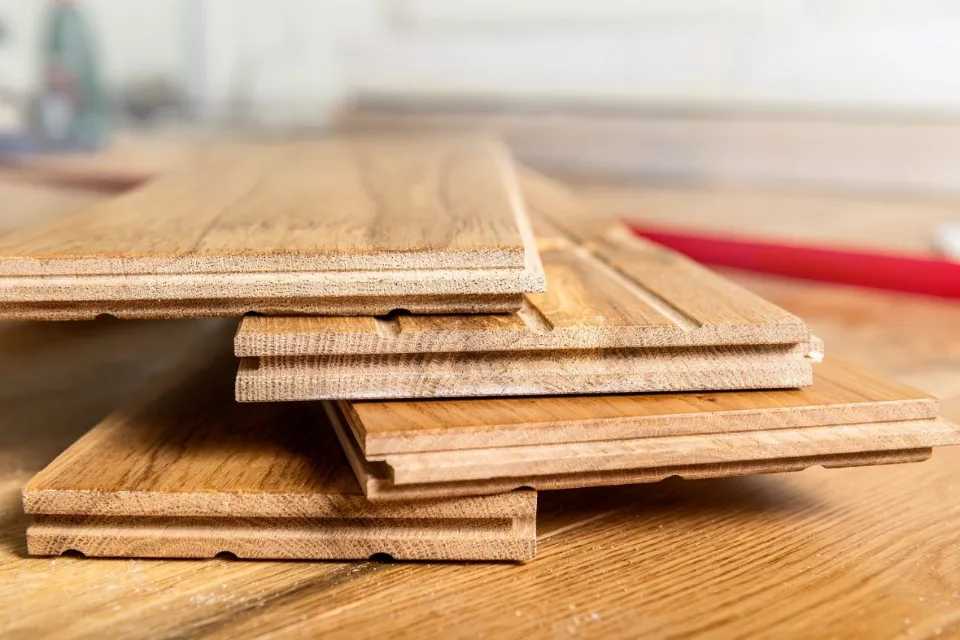
Appearance
Solid hardwood flooring boards tend to be narrower than engineered hardwood flooring. Solid hardwood generally has very tight seams between boards, and there is a great range of colors and species than is found with engineered hardwood flooring. Both pre-finished and unfinished boards of solid hardwood are offered.
Floorboards tend to be wider with engineered hardwood flooring. When compared to solid hardwood flooring, which typically has very tight seams between boards, some pre-finished engineered hardwood flooring has edges that are slightly beveled, creating slight grooves between boards. Engineered hardwood flooring is almost always sold pre-finished, and there is a narrower range of available colors and species than solid hardwood.
Construction
Solid hardwood is considered by many homeowners to be the “gold standard” in flooring. It is renowned for its longevity, authenticity, and timeless design because it is made from a single, solid piece of 100% hardwood. The Appalachian region is where hardwood is valued for its stability, consistency of color, and fine grain, and this is where Bruce solid hardwood flooring is primarily sourced from. Bruce solid hardwood flooring is made in the USA with fine American craftsmanship.
Engineered hardwood is made of layers with 100% natural wood on top, wood on the bottom, and a highly stable core in the middle. The core is made up of five to seven layers of plywood that have been pressed together in a crisscross pattern. This is what makes engineered hardwood flooring less prone to shifting, expanding, or contracting when exposed to alterations in the environment’s temperature, moisture content, and humidity.
Style and Species
Solid hardwood is available in Oak, Maple and Hickory, the species that are hardest and most resistant to wear. You’ll find many ways to add your own sense of style to your space with the wide range of widths available (up to 5 Prime), the abundance of colors, and the variety of textures.
Engineered hardwood offers many of the same design options as solid. In addition, you might come across designs that can only be made with engineered wood, like softer exotic species, unique textures, specific surface treatments, color effects, and extra-wide planks.
Installation Location
Solid hardwood flooring performs best in above-ground spaces, such as living and dining areas, kitchens and bedrooms. We do not advise installing solid in bathrooms or laundry rooms because of the potential for moisture and humidity.
Engineered hardwood flooring can go in the same rooms as solid hardwood, but its engineered construction also makes it a great choice for basements and over radiant heating and concrete floors. (Still, stay away from the restrooms and laundry rooms.) Because engineered hardwood is a little bit thinner than the majority of solid hardwood, it can be useful for projects where your hardwood floor needs to match the height of an adjacent floor or accommodate a narrow space beneath kitchen appliances.
Durability
Solid hardwood durability is mostly dependent on the product’s species and level of protective finish. For better scratch resistance, choose products with our Lifetime Finish and harder woods like Oak and Hickory. Harder woods also offer greater dent resistance. Solid hardwood floors typically last for many years, even after numerous sanding and refinishing sessions. (It’s unlikely that you’ll feel the need or desire to redo them.)
Engineered hardwood can also be sanded and refinished several times if the top layer is thick enough, though not typically as many times as solid hardwood. The Lifetime Finish on products will help them resist scratches the best, much like solid materials do. Choosing engineered hardwood flooring over solid hardwood is unquestionably the best option if moisture, humidity, or temperature are issues—such as in basement installations.
Cost
Pre-finished solid hardwood averages about $8 per square foot, within a range of $4 to $12 per square foot.
Engineered hardwood flooring is slightly less expensive than solid hardwood. The typical price range for engineered hardwood flooring is $2.50 to $10 per square foot, with the majority of types falling between $4 and $7 per square foot.
Lifespan
Solid hardwood typically lasts at least 30 years and as much as 100 years, since it can be sanded down and refinished several times.
Engineered hardwood flooring generally lasts 20 to 30 years.
Comfort and Sound
Solid hardwood has better acoustic properties than engineered hardwood. Its hardness evenly disperses the sound throughout the space while its density absorbs reverberation. Hardwood flooring is typically glued or nailed down to keep it stable. When first installed, hardwood floors will creak and squeak as the boards settle. A subfloor that is uneven or an installation problem may be the cause of creaking that persists after a few months.
As its name implies, solid hardwood is hard underfoot. Although a floating engineered hardwood floor is softer than other surfaces like tiles or concrete, it is still harder than other surfaces.
Engineered hardwood floors are usually “floating,” meaning it was snapped together over an existing floor with no adhesives or nails holding them down. The sound of walking on a floating floor can echo or make clicking noises, which can be distracting. Even though engineered hardwood’s sound absorption isn’t as good as that of solid hardwood, it still absorbs a lot of weight and noise thanks to its resilient surface, especially if you spend more money on a premium acoustic underlay to be installed beneath the floor.
Beware cheaper engineered hardwood floors made using a poor grade of plywood with hardwood veneer. They are prone to flaws, like the plywood separating and splitting. Being prone to breakage, plywood is not the best material for snap and lock flooring. Regular wear and tear may loosen the flooring causing squeaking.
Suggested reading: Types of flooring you can put over ceramic tile includes ceramic tiles, laminate flooring, vinyl flooring, carpet, epoxy coating, cork flooring, wood flooring, and new fired tile. But, why choose these floorings? Below will give specific reasons.
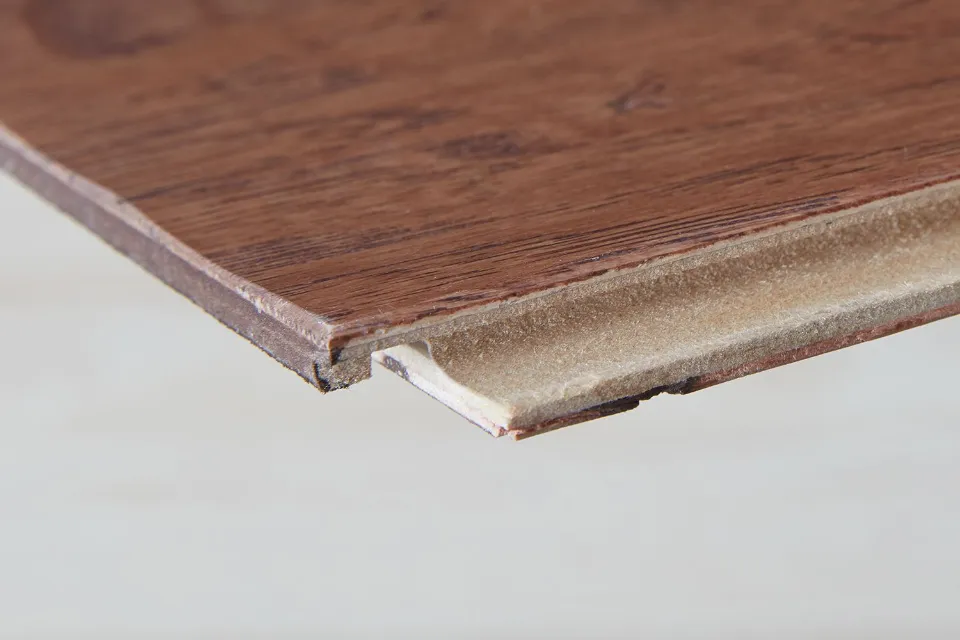
Water and Heat Resistance
They can withstand heat well, both kinds of hardwood. Neither material is recommended for installation in truly wet locations. Although it is more water resistant than solid wood, engineered wood is not waterproof.
Solid hardwood is not recommended for installation against concrete slabs, since humidity migrating through the concrete can cause solid hardwood to swell and warp.
Engineered hardwood has slightly better performance in humid locations since its plywood construction makes it more stable and less susceptible to warping. If installation against a concrete subfloor is necessary, engineered hardwood is the better choice.
Care and Cleaning
Solid Hardwood flooring is easy to clean with simple sweeping and vacuuming, and occasional damp-mopping with an approved wood cleaner.
Care and cleaning of Engineered Hardwood look the same as for solid hardwood: sweeping or vacuuming, and occasional damp-mopping with a wood cleaner.
The Advantages of Engineered Hardwood Flooring
- It is typically more affordable than solid hardwood flooring.
- It is difficult for you to tell it apart from solid hardwood flooring once installed.
- On top of it, a genuine hardwood layer is present.
- You will be able to use it in more versatile ways as it is more resilient to changes in temperature and humidity than solid wood flooring.
- It is a very stable product that can be installed over an underlay, with underfloor heating, and in conservatories.
- If necessary, it can also be fixed to the subfloor.
- It will be quick and simple to install engineered hardwood if you choose one with a click system.
- You will have a choice of different wood species, styles, colours, finishes and plank sizes.
- If necessary, you can sand the top layer of real wood and refinish the flooring.
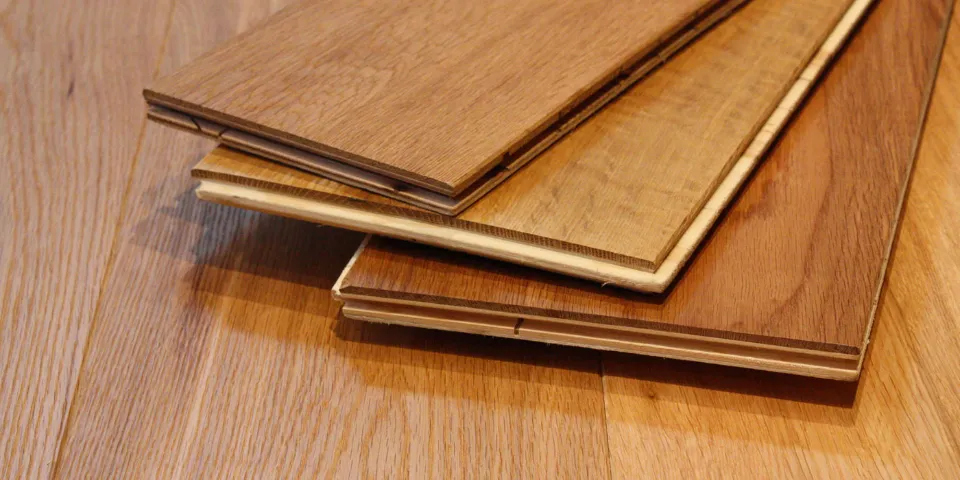
Advantages of Solid Hardwood Flooring
- This style of wood flooring is the most opulent and conventional.
- One solid piece of hardwood is used to make each plank.
- If and when necessary, you can sand and refinish your flooring several times.
- Your solid wood flooring has a long life expectancy, offering a timeless and charismatic appeal.
- There are many different species of solid wood flooring available, ranging from light to dark with various patterns and grains.
- The solid flooring planks come in a variety of widths and lengths so you can select something that complements your surroundings.
- The more conventional and established installation technique is the tongue and groove fitting system.
- You can get solid wood flooring in either unfinished or pre-finished planks.
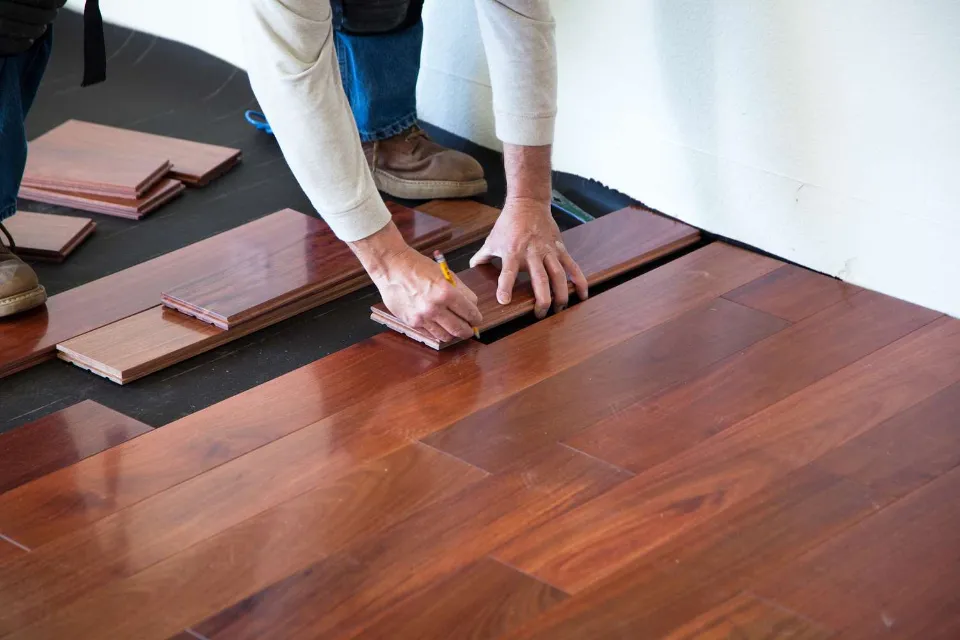
Where Do You Want to Install the Flooring?
Your decision regarding engineered vs. solid hardwood flooring may be influenced by where the flooring will be installed. Given that it can be repeatedly sanded and refinished, solid wood flooring is excellent for high traffic areas. So if you are looking for flooring for an entrance hallway or living area then solid wood flooring could be a good option. If however, you want hardwood flooring for a room where temperature or humidity is continually fluctuating, we would recommend engineered hardwood. As an illustration, conservatories, rooms with lots of glazing, or even a kitchen. Engineered hardwood flooring can handle changes in air temperature or humidity because it is made to withstand slight environmental changes.
FAQs
Is Engineered Wood as Good as Real Wood?
It doesn’t respond well to being moved or used for extended periods of time and disintegrates if it gets wet. Scratches and water stains on engineered wood cannot be fixed, making it more prone to damage. Contrarily, the main benefit of solid wood is that it can be sanded and refinished numerous times over the course of its lifespan.
Is Engineered Wood as Strong as Solid Wood?
Engineered wood can be stronger than dimensional lumber because of its high density and layers of grain running in different directions. Engineered beams can be made in almost any size because they are made from composite materials rather than having to be cut from individual trees, which allows for larger members.
What Are the Disadvantages of Engineered Wood Flooring?
When creating their engineered hardwood flooring, some manufacturers use subpar or cheap materials. Make sure you buy from reputable manufacturers to ensure you get a long lifespan out of your new flooring. Some products made of engineered hardwood can’t be refinished.
Does Engineered Wood Look Cheap?
Engineered wood floors are “fake” and “cheap” compared to solid wood floors. This could be accurate for a few of the extremely affordable engineered floors. But a good engineered floor will have the same appearance and texture as a good solid hardwood floor.
Summary: Engineered Wood Vs. Solid Wood Flooring
As the name implies, solid wood flooring is made entirely of wood throughout its thickness, typically a species of hardwood like oak, maple, or walnut. Its significant advantage is that it can be sanded and refinished numerous times throughout its lifespan.
Engineered wood flooring has a similar appearance at first glance, but it is actually made of a high-quality plywood substrate covered in a relatively thin layer of hardwood. Engineered flooring is slightly less expensive than solid hardwood, but most varieties can only be sanded and refinished once or twice because the surface hardwood layer is so thin. There is no definite advantage to one type of wood flooring over the other if you’re trying to compare the benefits of engineered wood flooring or decide which is better. Your decision will be based on how much you value each option’s relative advantages.
If you have any questions, please leave a comment. My Prime Home tries to give you the best home improvement information. Don’t forget to share the post. Thank you for reading.
